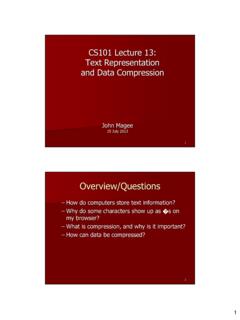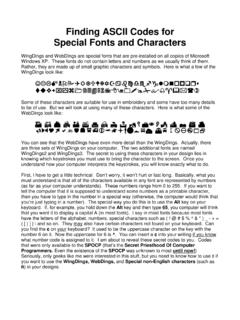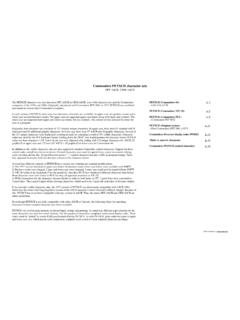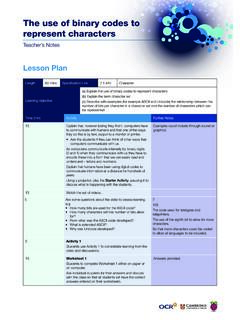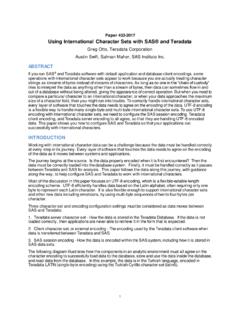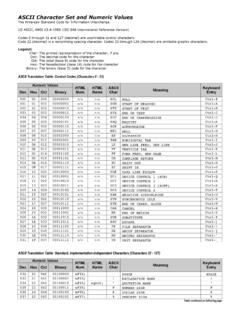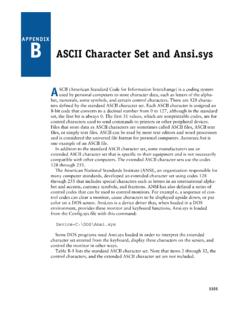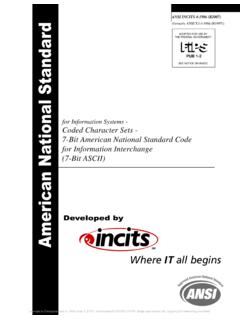Transcription of If You Have to Process Difficult Characters: UTF-8 ...
1 1 Paper 1163-2017 f have to Process Difficult characters: UTF-8 encoding and SAS Frank Poppe, PW Consulting ABSTRACT Many SAS environments are set up for single-byte character set s (SBCS). But many organizations now have to Process names of people and companies with characters outside that set, like in f have . You can solve this problem by changing the configuration to the UTF-8 encoding, which is a multi-byte character set (MBCS). But the commonly used text manipulating functions like SUBSTR, INDEX, FIND, and so on, act on bytes, and should not be used anymore. SAS has provided new functions to replace these (K-functions). Also, character fields have to be enlarged to make room for multi-byte characters. This paper describes the problems and gives guidelines for a strategy to change. It also presents code to analyze existing code for functions that might cause problems. For those interested, a short historic background and a description of UTF-8 encoding is also provided.
2 Conclusions focus on the positioning of SAS environments configured with UTF-8 versus single-byte encodings, the strategy of organizations faced with a necessary change, and the documentation. INTRODUCTION Many SAS environments are set up for single byte character sets (SBCS), most often some form of extended ascii . Because of several trends, which can loosely be described as globalization , organizations are now being confronted with names of people and companies that contain characters that do not fit in those character sets. They have uncommon accents and other diacritical signs, like the characters in the title. Organizations working in a Japanese or Chinese environment have , for some time, already the opportunity to use SAS with a double byte character set (DBCS). But since then a more general solution has become available. The Unicode system has been developed, and is now maintained by the internationally recognized Unicode consortium. All known characters and symbols for any languages are given a c ode point.
3 At the same time systems have been developed to encode these code points in bytes. These all need more than one byte, and thus are multi byte character sets (MBCS). The most widely used of those is the UTF-8 encoding, which is a using one to four bytes. Most web pages nowadays use UTF-8 , and it is also the default encoding for XML. Switching an existing SAS installation from any SBCS encoding to UTF-8 is no trivial task, alas. Commonly used text manipulating functions in SAS like SUBSTR, INDEX, FIND, etc., act on bytes, and do not take into account that a character now may need more than one byte. And character variables need more bytes to contain the same number of characters, if the text contains characters that take more than one byte. The problems with these old functions, acting on bytes instead of on character , are described, and syntactic differences with the new K-functions that replace them are indicated (there is KSUBSTR and KINDEX, but no KFIND ).
4 Some guidelines are given for determining the extent to which character fields need to be enlarged to contain multi byte characters. To assess the changes needed in existing code an approach is described to search code for occurrences of character functions that should not be used for multi byte characters. The code tries to fi nd the actual occurrences of function calls in the code, ignoring function names in comments or variable names that are equal to a function name. The full SAS code is appended. Pointers are given to relevant documentation on the web. Also some historical background to encoding is given, to put everything in context. This is accompanied by a description of the UTF-8 encoding method itself. 2 Conclusions will focus on the positioning of UTF-8 configured SAS environments versus single byte encodings, on the strategy of organizations faced with a necessary change, and on the documentation. THE PROBLEM In this paragraph first some background is being given, and then how you might notice them in practice.
5 THE BACKGROUND There are three areas to discuss here: The character functions in the Data Step and in Macro code. The width of the variables to store character values. The Input statement. character functions The often used character functions in SAS like SUBSTR, INDEX, etc., act on bytes, not on characters. And they will continue to do so. This is understandable because some applications expect them to do that, also when working with multiple byte characters. , when encoding a long character string towards BASE64 it has to be cut in smaller strings with a specific number of bytes, regardless of character boundaries. But in most case one wants to Process characters, not bytes. The following Data Step code snippet illustrates this: name = 'B lasz' ; name2 = substr ( name , 1 , 2 ) ; put name2 = ; In a single byte configured SAS environment one see: name2=B And, usually, one will also want to see that in a UTF-8 configured environment. But the result will be like this: name2=B The character takes two bytes in UTF-8 , the hex values 'C3'x and 'A1'x.
6 The SUBSTR function selects two bytes: the B and the hex value 'C3'x, and if that hex value is shown in itself it has no meaning (this will be explained in the section on the UTF-8 encoding method), leading to the questionmark-in-a-black-diamond. Using the alternative KSUBSTR does give the desired result: name2 = Ksubstr ( naam , 1 , 2 ) ; will give again: name2=B Note that these K-functions can be used in all environments, also when operating in a single byte environment. So it would sensible to stop using the old functions, and start using the K-functions exclusively. 3 Variable length But note also that the string "B " stored in the variable name2 now is three bytes long. If the variable would have been defined with a length of $2 it will still produce B . The KSUBSTR function produces the right three bytes, but the last one is still lost when storing it into the variable. So the length of all character fields will have to be considered. In general fields that contain codes and such are not in danger.
7 Also codes that are being maintained externally usually use only the simple ascii characters. , the codes defined by the ISO organization for country, currencies, etc., all only use ordinary (capital) characters. But any field that comes from the real world and may contain names of people, organizations, etc., may contain some, or many, multi byte characters. The INPUT statement When reading external files in a Data Step one also has to take into account the possibility that they nowadays often will be in UTF-8 format. Reading files using an input statement that relies on separators between the fields will not be problem. So if the fields are being separated by spaces or tabs, or by semi-colons or comma s, there will not be a problem, provided of course that the variables receiving the values that are being read have a length large enough to receive any multiple byte characters. But input statements that rely on character positions, or think they are, can cause problems.
8 Take the following two statements. INPUT @3 Naam $. ; INPUT naam $ 3-23 ; If the first two columns contain characters that take up more than one byte, the statements probably do not produce the intended results. There does not seem to be a reliable method to use a column oriented INPUT statement when dealing with multi byte formatted input files. THE PRACTICE How do you notice that you will have to convert from a SBCS encoding to a MBCS? And how do you notice after converting that some consequences seem to have been overlooked? Running in a SBCS environment If external files that were formatted using a MBCS encoding are being processed in a SAS environment that uses the Latin1 encoding, or a similar SBCS encoding, a problem can surface in several ways. It can remain hidden for a while when the multi byte characters can be mapped to the extended ascii set used. Characters like , , etc., take two bytes in a MBCS encoding, but do exist in most SBCS encoding. In some instances (particularly when using EG to display input or output) some characters are silently changed to simpler forms, by omitting the diacritical signs (the accents).
9 Empty spaces appear where characters are being expected. A warning in the log appears that some characters could not be transcoded , meaning that they could not be mapped to a codepoint in the SBCS encoding. When using the XMLV2 engine the same situation generates an error (which is a rather surprising difference with the previous point). 4 Running in a MBCS environment When your environment is already configured with a MBCS encoding, there still might be problems. These all are variants of the two situations already described: A SAS string function not suitable for a MBCS environment is being used. A character field is not wide enough (in bytes) to hold all characters. Neither of these produce in general warnings or errors in the SAS log. So the only way these problems can surface is that somebody notices unexpected results. Of course, it can then happen that that situation has been existing for quite some time. Therefor it is a good idea to do a thorough analysis before using existing code in a MBCS environment.
10 In a next paragraph some advice is being given how to transfer from a SBCS to a MBCS environment. HISTORY: UNICODE AND UTF-8 A SHORT DEVELOPMENT OF ENCODING In a file each character is stored as a code. At the start of the computer era the code could always be stored in one byte. Immediately different code tables emerged. One of the oldest and most widely used system is the ascii encoding, using the codes 0 through 127 (using 7 bits). (Another well used coding standard is EBCDIC.) The remaining bit was used as a control character to minimize the chance of transmit errors. The first 32 of those (0 through 31) are control characters , the best known being number 10 (linefeed, or LF), 13 (carriage return, CR) and 27 (escape, ESC). Number 32 is the space, and then follow the visible characters. The last one in the series, 127, is delete (DEL). After some time also the eighth bit was taken into use, because transmission became reliable enough to make a control bit superfluous.










